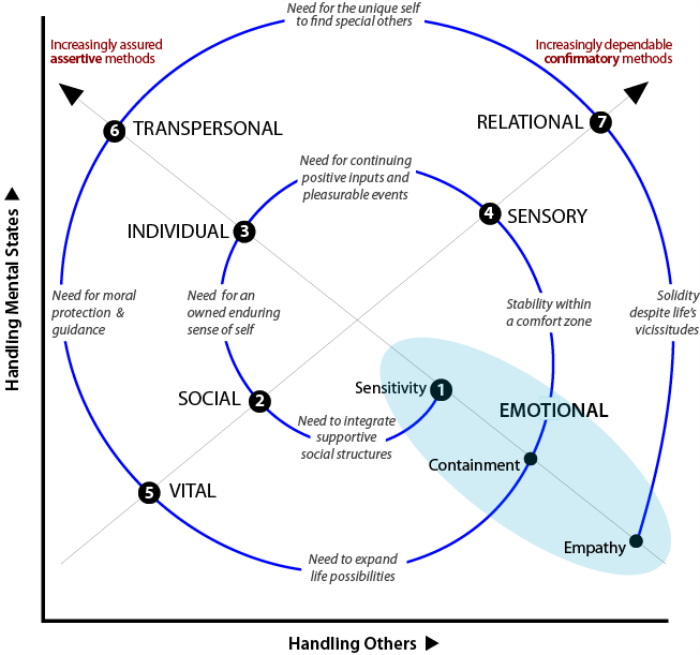Preview of the Framework
The enjoins: keep in touch!
and is stabilized by: Stimulation.
The enjoins: keep fit!
and is stabilized by: Concentration.
The enjoins: have feelings!
and is stabilized by: Attachment.
The enjoins: maintain self-esteem!
and is stabilized by: Respect.
The enjoins: cultivate relationships!
and is stabilized by: Attunement.
The enjoins: contribute purposefully!
and is stabilized by: Participation.
The enjoins: embrace spirituality!
and is stabilized by: Faith.
For more, see the matrix summary.
The Trajectory in Brief
The natural sequence of (value-sets) to be installed traces out a spiral trajectory when plotted on the . As the values at each cumulate, the becomes progressively stronger and a person is more .
The starts in the , which enables an immediate necessary sense of existence and uniqueness. This is a matter of and a willingness to own them.
However, it soon becomes evident in social situations that your , though unmistakable and perhaps lovable, is somewhat unstable. You cry more than most. Your varying feelings make you unpredictable or even unreliable—and not only in the eyes of others.
It is common to become dissatisfied with the volatility and to doubt your own motivations and goals. Personal life may become chaotic or excessively inhibited to compensate for the seeming vulnerability intrinsic to emotional lability. The first challenge may therefore be labeled: "" (as represented in : and this is what is about.
The various instigators of transition are shown in the diagram below and then briefly explained.

Growth Stages 1 → 2 → 3 → 4 give you more and better control over your motivated presence.
Stage 1 is almost automatic in a healthy person. It starts with sensitivity to your own feelings, which is the basis of the .
But this solo self-management and self-assertion can be hard to sustain.
In Stage-2, values from the enable development of a public identity with unambiguous distinctiveness and an associated social acceptance and public support.
But, over time, your willingness to conform to group norms may diminish because they seems too inhibiting and controlling.
So in Stage-3, values from the enable you to develop a private and defined self-concept which can be owned and positively valued apart from any particular social group.
But, over time, privacy can lead to a loneliness and disconnection which then impairs self-esteem and potentially disturbs others in your groups.
So in Stage-4, values of the enables you to feel good and socially connected through a regular flow of positive recognition and basic pleasures in congenial company.
Having reached this point, the original «can now be referred to as «» and its emotions are
Cycle-1 starts with a from the and concludes by spontaneously re-entering to generate a . That assures a natural—so long as you stay within your comfort zones.
Growth Stages 4(1) → 5 → 6 → 7 allow you to experience greater meaning via self-actualization.
is a process in which comfort zones lose their attraction, so that unknown parts and potentials of the self can be realized. The first step involves becoming mentally and bodily energized.
In Stage-5, values of the enable the selection of new, suitable challenges that draw on your deeper potentials.
But new and demanding activities expose a person to dangers. Given development so far, only protection and guidance that are moral or ethical in nature will be willingly accepted.
So in Stage-6, values of the enable an ethical and authentic mode of living that is experienced as fully defensible.
But the selflessness that is required can be too isolating, and individuality may become too inward.
So in Stage-7, values of the enable a specialness to infuse encounters with a select number of individuals.
Having reached this point, a person now possesses a natural and consistent capacity.
Cycle-2 concludes by re-entering the to generate a more attuned and appropriate that ensures automatic consistent . is now solid and resilient in the face of life's vicissitudes, whatever they may be.
![]() Emotions are Central for the Self
Emotions are Central for the Self
- The full story is far more interesting and it starts here.
- See a more detailed summary in the final Review.
Originally drafted: 4-Jan-2016. Last amended:25-Jan-2016.
